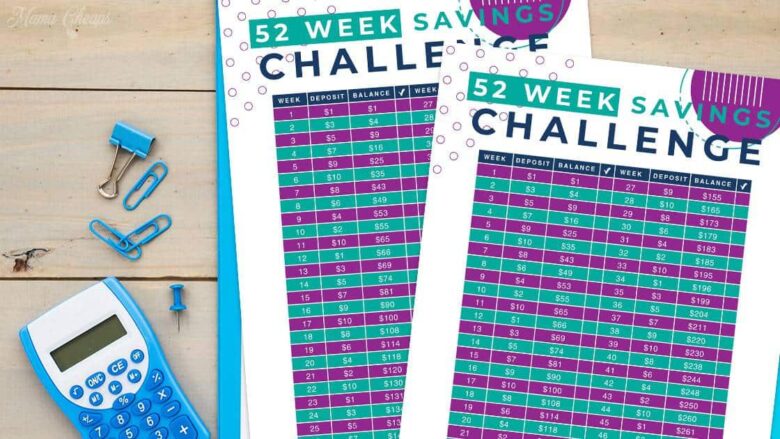The 52-Week Savings Challenge is a popular and easy way to get into the habit of gradually saving money over the course of a year. The idea behind this challenge is that you start with a small amount of savings the first week. Then you gradually increase the amount you save each week for the entire year. Typically, the goal is to save $1 the first week, $2 the second week, $3 the third week, and so on, until you have saved $52 by the last week. If you do the challenge correctly, you will save $1,378 by the end of 52 weeks. For many people, this amount is an achievable goal and a great way to develop a regular saving habit.
Why This Challenge Appeals to So Many People
The appeal of the 52-Week Savings Challenge is its simplicity. It doesn’t require a complicated financial strategy or a lot of money to get started. Whether you’re a student, a full-time worker, or someone on a fixed income, anyone can get started. When you start with so little, the challenges seem manageable. It’s not difficult to save a dollar in the first week; gradually increasing the amount helps participants develop the habit of saving money. This slow approach makes saving money seem possible rather than overwhelming.
Using Technology to Help You Reach Your Savings Goals
When you’re facing the 52-week savings challenge, technology can be a helpful friend. Many banks offer automatic deposit services, which allow you to deposit your weekly installments into another savings account. Budgeting tools and apps allow you to track your progress and receive notifications. By implementing automation, you can eliminate the urge to use money and the need to remember to make your weekly deposits. The easier it is to stay consistent and avoid skipping weeks due to forgetfulness or distraction, the better you can streamline your routine.
Avoiding Common Challenge Pitfalls
Inconsistency is one of the biggest factors that causes many people to give up on the 52-week savings challenge. While it may seem harmless at first, skipping a week or two can break a habit and cause you to give up on the challenge altogether. Planning ahead and saving each week can help prevent such an event from happening. You can establish a regular habit by setting a reminder every Friday or by linking your savings to other weekly tasks, such as grocery shopping. Only use the money when necessary, as it can ruin your motivation and undo weeks of work.
Find Extra Funds to Keep the Activities Going
As your total savings grows, you may need to find unique ways to collect your weekly cash. The task doesn’t have to be difficult. To earn some extra cash, you can save change, sell unwanted items, cut out coffee, or eat out less often. When you treat saving as a weekly challenge rather than an obligation, it can be fun to find new ways to reach your goal. These small sacrifices each week can add up to giant rewards; each successful deposit brings a greater sense of achievement.
Hold a Friend or Family Member Accountable
You may find it easier to stay motivated and have more fun if you join a friend or family member on a 52-week savings challenge. It’s easier to share advice, celebrate successes, and take responsibility when someone else is on the same path. Some people even form small savings groups to motivate and support each other when life gets tough. Friendly competition can also motivate you to keep going. If you know others are watching, you may want to skip a week.
Reward Yourself for Milestones Along the Way
Sometimes saving money seems like a good thing, especially when the benefits are limited. It will be easier to stay motivated if you schedule moderate incentives to overcome challenges at certain points along your journey. For example, after you save your first $100 or after you complete week 26, buy yourself a modest, reasonably priced gift. These small celebrations can motivate you and give you positive feedback, helping you overcome challenges. The reward should be meaningful but affordable; just make sure it doesn’t hinder your financial progress.
Reflecting on Your Progress and Growth
Once you complete the 52-week savings challenge, you may see more than just the money you’ve saved. Your discipline, patience, and ability to budget are also a reflection of your personal development. The challenge isn’t just about saving money; it’s also about developing a better financial mindset. You’ll likely become more aware of your spending habits and be better prepared to manage future unforeseen expenses. Your financial life in other areas will reflect the confidence and satisfaction you gain from doing so.
Use your Savings for Important Things
Once you’ve completed the challenge, you can use the money you save to buy something important or valuable. You can use it to pay off debt, as an emergency fund, for home improvements, or for a vacation. If you make wise decisions about how you spend your money, it can justify all your hard work. It also emphasizes the need to save regularly and shows you what you can achieve if you follow your financial goals. One of the most satisfying aspects of adversity is seeing the tangible benefits of your efforts.
Conclusion
If you’re looking to build a saving habit, the 52-Week Savings Challenge is a helpful and inspiring tool. The step-by-step approach makes it seem achievable, and the increasing weekly contributions gradually help you build your financial discipline. The secret is consistency and dedication, whether you follow the original format or adapt it to your needs. Along the way, you’ll learn useful money management skills and develop a mindset that will support your long-term financial health. If you stick with it, you’ll have a healthy savings account by year’s end, and you’ll see that with a little effort, you can reach your financial goals.
FAQs
1. How much total can you save after completing the 52-Week Challenge?
If you had followed the original strategy, you would have saved $1,378 by the end of 52 weeks.
2. Can I change the difficulty level if the first strategy doesn’t work for me?
Of course, you can change the weekly total or set aside a certain amount each week, depending on your budget and lifestyle.
3. Should I skip a week?
If you miss a week, try to catch up the next week or spread the missed hours over the following weeks. It’s important to get back on track as soon as possible.
4. Where should I keep my savings during difficult times?
Consider a secure pot-envelope system or a unique savings account. By withdrawing money from your account daily, you can reduce the need to spend .
5. Is the 52-week challenge suitable for beginners?
Of course, it’s simple and easy to use for beginners. For people who are just starting to save, it’s fine to start with a small amount.




